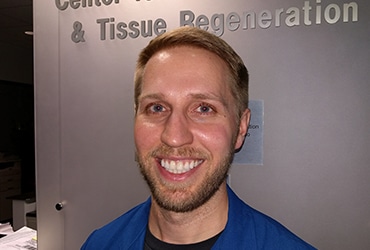A Mechanosensitive Hormone Signaling Pathway Increases Breast Cancer Risk
By Alice Bradbury, PhD
In the US, nearly half of all women have high mammographic density (MD), associated with an increased lifetime risk of breast cancer (1). A recent study published in Cell Stem Cell uncovered how a stiff extracellular matrix (ECM), such as that observed in high MD breast tissue, promotes ERK activity, progesterone receptor-dependent RANK signaling, and increased stemness (2). These findings point to the potential benefit of RANK signaling inhibition as an anti-cancer treatment and prevention strategy, especially in individuals with high ECM stiffness, such as those with high MD.

The study was led by Jason Northey, PhD, a postdoctoral research associate at the University of California, San Franscisco. A two-time AACR grant recipient, Dr. Northey was first awarded the AACR Basic Cancer Research Fellowship in 2015 for his study titled “Mitigating the biophysical implications for breast cancer risk.” He then received the AACR-Janssen Fellowship in Cancer Interception Research in 2017 for his research project, “Tissue tension promotes stemness and breast cancer aggression.” He said, “I am so grateful for AACR grant support which was vital in affording me the time, security, and resources to pursue this research in depth and advance it to the publication stage at Cell Stem Cell.”
Dr. Northey and his colleagues first sought to elucidate how a stiff ECM can promote the expansion of tissue-resident stem-progenitor cells. They examined stiff high MD breast tissue from pre-menopausal women and confirmed there was a higher number of stem-progenitor mammary epithelial cells (MECs) compared to tissue from low MD individuals and increased activated β1-integrin levels. To investigate the link between these features, they utilized a mouse model expressing a mutant human β1-integrin (V737NM) that promotes focal adhesion assembly and integrin signaling (designed in their laboratory), and a second expressing a collagenase-resistant mutant of collagen I (COL) that increases collagen density, stromal stiffness, and integrin signaling. By comparing the mammary glands of these mice to control mice, they showed that elevated integrin mechanosignaling and stromal density and stiffness support the expansion and activity of stem-progenitor MECs.
Given that progesterone-induced paracrine RANKL/RANK signaling is known to modulate MEC and progenitor cell expansion in the mammary gland (3), they evaluated RANKL/RANK signaling in the mammary glands of the V737NM and COL mice. In addition to observing increased RANKL/RANK gene and protein expression, they found that treatment with a RANKL inhibitor reduced the number of stem-progenitor cells and activity in basal MECs isolated from V737NM and COL mice.
Activity of the progesterone receptor (PR) can be modulated by ERK phosphorylation of Serine 294 (S294). The research team performed immunoblot analyses to measure pPR-S294 in nuclear lysates of mammary glands and found markedly elevated pPR-S294 in the mammary glands from V737NM and COL mice compared to those from wild-type mice. Furthermore, treatment of V737NM mice with the ERK inhibitor temeturkib decreased basal progenitor activity.
Confirming the clinical relevance of this stiffness-enhanced, ERK-induced, progesterone-RANK signaling pathway, they found elevated levels of phospho-ERK, pPR-S294, and RANKL by immunofluorescence analysis in breast tissue from patients with high MD. By analysis of RANKL gene expression in high MD and low MD regions of the same breast, they also showed there was a significant correlation between stromal stiffness and RANKL levels.
Reflecting on the study findings, Dr. Northey said, “We found that stromal stiffness promotes integrin mechanosignaling to expand the frequency of mammary epithelial progenitor cells through a progesterone-RANKL signaling axis. Importantly, we linked this process to elevated tumor initiation, suggesting that RANK inhibition may help prevent tumor development and progression in individuals with high breast density.”
Dr. Northey will soon transition to an independent faculty position in the department of biochemistry at the University of Alberta. Receiving the AACR fellowships, “helped me to connect with like-minded colleagues and patient advocates and build my professional profile with the qualifications necessary to obtain an independent faculty position,” he said.
References:
- McCormack VA, dos Santos SI. Breast density and parenchymal patterns as markers of breast cancer risk: a meta-analysis. Cancer Epidemiol Biomarkers Prev. 2006; 15: 1159–1169.
- Northey JJ, Hayward M-K, Yui Y, Stashko C, Kai F, Mouw JK, et al. Mechanosensitive hormone signaling promotes mammary progenitor expansion and breast cancer risk. Cell Stem Cell 2024; 31:106-126.
- Joshi PA, Jackson HW, Beristain AG, Di Grappa MA, Mote PA, Clarke CL, et al. Progesterone induces adult mammary stem cell expansion. Nature 2010; 465: 803–807.